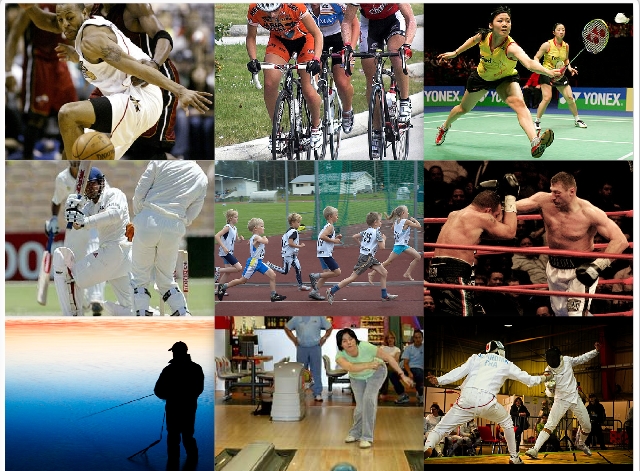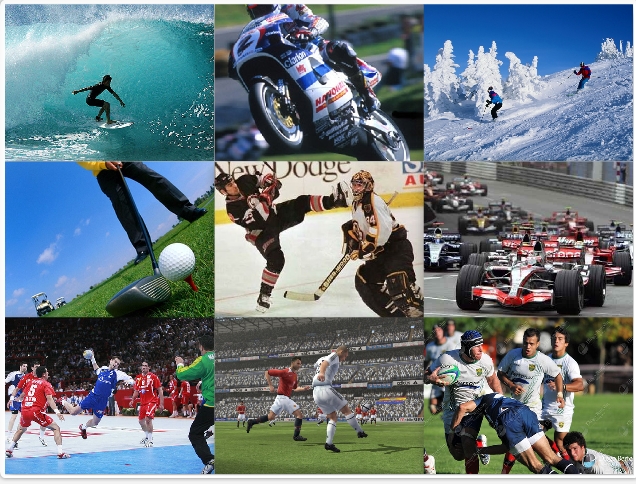
If you “flee” you run away, as from trouble or danger. This verb is irregular : flee-fled-fled
Ex: He fled from the house into the night.

If you “flee” you run away, as from trouble or danger. This verb is irregular : flee-fled-fled
Ex: He fled from the house into the night.
Still on the subject of sports, today let’s focus on a writing activity where you’ll have to make use of lots of things learnt this week, namely
What to do?? Simple!!! Look at the following pictures. What do they all have in common? Exactly!! They’re all sports.
What do you have to do? Choose a sport and give a good definition for it, mentioning everything you know about it as regards equipment, rules of the game, where you can practise it…etc. Make sure you do not write the name of the sport as we, readers, will have to guess the name of the sport you are describing.
Need a dictionary? Here : Monolingual http://dictionary.cambridge.org/
Bilingual http://www.wordreference.com/es/
Ready??


Victory belongs to the most persevering. Napoleon Bonaparte
There are no gains without pains. Adlai Stevenson
These inspirational quotes are aimed at people who need some sort of encouragement when finally and after years of putting off taking up some kind of exercise they have finally decided to come to terms with the acute necessity our body seems to have for some sort of physical activity.
Couch potatoes are not trendy but let’s face it ,going to the gym doesn’t guarantee a six pack, flat abs and a tight butt . In fact, if you are thinking that by overworking your body you’re going to look like Naomi Campbell or Hugh Jackman , you’ll soon give up. Engaging in sports activities like tennis, football and even walking for an hour or so will keep you interested for a longer time . But if you find these sports too boring or too conventional , why don’t you try any of these ??
Pancake Racing : In which each participant carries a pancake in a frying pan. All the runners must toss their pancakes as they run and catch them in the frying pan.
All the runners must toss their pancakes as they run and catch them in the frying pan.
Welly/Wellie wanging or throwing – A freestyle sport that originated in Britain, most likely in the county of Yorkshire. Competitors are required to hurl a Wellington boot as far as possible within boundary lines, from a standing or running start. Each player has three throws, the longest distance thrown within the zone wins. Note that the word wellie is also often spelt as welly.
Wheelbarrow and Straw Bale Race – Each player in the team races over 50 yards with 4 straw bales on the barrow, then tosses the bales over a 6ft height bar. The quickest team wins.
Cheese-Rolling – During the annual Cooper’s Hill Cheese-Rolling and Wake, competitors race down a steep hill in Gloucestershire, attempting to catch a Double Gloucester cheese which has been set rolling from the top. Often this results in many injuries.
Haggis hurling or throwing – A Scottish game involving, yes you guessed it, throwing a haggis. Modern Haggis Hurling is judged on the basis of distance and accuracy of the throw (hurl) and a split or burst haggis is immediately disqualified, as the tradition dictates that the haggis must be fit to eat after landing, yummy. The sport requires subtle technique rather than brute force, as the hurl must result in a gentle landing to keep the haggis’ skin intact. Despite it’s eccentricity, the practitioners take the sport seriously, with a World Haggis Hurling Championship. Haggis Hurling was even supposed to be presented as a demonstration sport at the 2004 Summer Olympics. Plans to use a fake haggis in a hurling competition at a Highland festival in Melbourne have split the purists from those who are fearful of the mess a high-speed impacting example of Scotland’s national dish may cause (see Haggis gets a bashing from fakes). It is unclear to the uninitiated if the sport promotes the enjoyment of this often maligned delicacy (to which a famous ode of praise was once composed by Robbie Burns himself). According to a Canadian source that disapproves the practice as insensible, the haggis is the main event at the annual Burns Night celebrations held by Scots and Scottish wannabees the world over.
Now , have a look at this diagram you have helped me build with your contributions during the lesson. I have used a tool called Gliffy, which I recommend since it’s free.